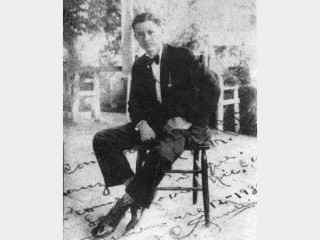
Augusto C. Sandino biography
Date of birth : 1894-05-18
Date of death : 1934-02-21
Birthplace : Niquinohomo, Nicaragua
Nationality : Nicaraguan
Category : Politics
Last modified : 2010-12-29
Credited as : Politician, and leader of Nicaraguan guerrilla movement,
Augusto C. Sandino was the leader of a Nicaraguan guerrilla movement which opposed United States Marine intervention in that country from 1927 to 1933. His opposition galvanized anti-American feeling throughout Latin America and helped convince U.S. policy makers that military intervention was often self-defeating.
Augusto Calderon Sandino was born in the village of Niquinohomo on a date variously given but probably May 18, 1894, to Gregorio Sandino and Margarita Calderon, a servant girl. For several years Gregorio neglected his illegitimate son, who lived with his mother in poverty. At age 11 Augusto went to live in the house of his father, who had married America TÃffer. He attended primary school in his village and an institute in Granada, Nicaragua, after which he became a produce merchant. When he had trouble with a local political chief he left home for Honduras and Guatemala, eventually arriving in Mexico in 1923, where he worked in the oil industry around Tampico. There he observed Mexican nationalism, and when Mexicans chided Nicaraguans for their lack of patriotism he began thinking about United States interference in his native land. He formed a social and political philosophy that Nicaragua's problems lay in politicians and American imperialism.
Sandino returned to Nicaragua in 1926 during the political disturbances following Conservative Emiliano Chamorro's ouster of President Carlos Solorzano and Vice President Juan B. Sacasa (supported by the Liberals). He worked briefly for an American-owned gold mine, where he talked with workers about the need for a government to protect them from exploitation by captialists and foreign-owned companies. According to one account he told them he was not a Communist but a socialist.
Sandino's decision to take up arms may have been influenced initially by his strong Liberal background reacting against Conservative control as much as by a reaction against the intervention. When his attempt at independent military action in the revolution against the Conservatives failed, he decided to join forces with the Liberals headed by Juan B. Sacasa, a claimant for the presidency who had returned from forced exile and set up a government on Nicaragua's east coast. Sandino's relationship with the Liberal military and political leadership was not close, but according to his own account he gave valuable service to the cause, even at one time preventing rout of the main Liberal force.
In April 1927 Henry L. Stimson, special representative of President Calvin Coolidge, arrived in Nicaragua to stop the fighting and, through threatened forcible disarmament, arranged a settlement in talks at Tipitapa with General José MarÃa Moncada, Sacasa's minister of war. The settlement provided for United States supervision of the next presidential election to meet the Liberal complaint that revolution was the only way for them to regain power since Conservative-controlled elections would not be fair. Despite general Liberal acceptance of the Tipitapa terms, Sandino refused them and escaped with a few followers to northern Nicaragua, where he launched a guerrilla campaign against U.S. Marines and the Nicaraguan government. Trying to hold his small force together, Sandino moved to San Rafael del Norte, where, on May 18, 1927, he married Blanca Arauz, a young telegrapher whom he had met earlier in the revolution.
At first Sandino's moves did not cause alarm because most of the revolutionaries surrendered their arms and the American military did not believe the others would offer effective resistance. Sandino's failure to stop Marine and Nicaraguan national guard occupation of northern towns seemed to confirm this view. Nonetheless, Sandino's attack on the Marine garrison at Ocotal on July 16, 1927, alarmed Washington and brought international attention to the Nicaraguan nationalist who might have won the battle but for the timely intervention of U.S. warplanes. Sandino's attack on a well-fortified enemy was a mistake and led his followers, the Sandinistas, to develop more refined methods of guerrilla warfare. Although the guerrilla leader was unable to prevent American supervision of the Nicaraguan elections of 1928, 1930, and 1932 or formation of an American-trained national guard, he was never captured and was able to win support in Latin America and the United States as he continued his hit and run tactics. Sandino's activities led Washington to reconsider the issue of military intervention and helped lay the groundwork for the principle of nonintervention in the Good Neighbor policy.
During Sandino's resistance, the Communists looked upon him as an important leader in the anti-imperialist struggle and sought to influence him. The relationship, one of convenience only, was strained when Sandino temporarily left for Mexico (1929-1930) and later, when Sandino made peace with Managua, there were charges of betrayal.
After U.S. Marines withdrew from Nicaragua in January 1933, Sandino and the newly-elected Sacasa government reached an agreement by which he would cease his guerrilla activities in return for amnesty, a grant of land for an agricultural colony, and retention of an armed band of 100 men for a year. There followed a growing hostility between Sandino and Anastasio Somoza Garcia, chief of the national guard, which led to Sandino's abduction and death during a visit to Managua on February 21, 1934. Sandino's death removed a major block to Somoza's drive for power and a Somoza family dictatorship which lasted from 1937 to 1979. Years later, Sandino's anti-imperialism influenced opposition to the Somozas and inspired formation of the Sandinista Front of National Liberation, which brought the downfall of the dictatorship in 1979.
Neill Macauley's The Sandino Affair (1967) details U.S. Marine activities against Sandino. Lejeune Cummins in his Quijote on a Burro: Sandino and the Marines (1958) reflects that Sandino crystallized Latin American sentiment against the United States and forced reexamination of policy. A Search for Stability: United States Diplomacy Toward Nicaragua, 1925-1933 (1968) by William Kamman puts Sandino in the context of U.S.-Nicaraguan relations.
















